Jazz keen to strike happy tune when golf returns
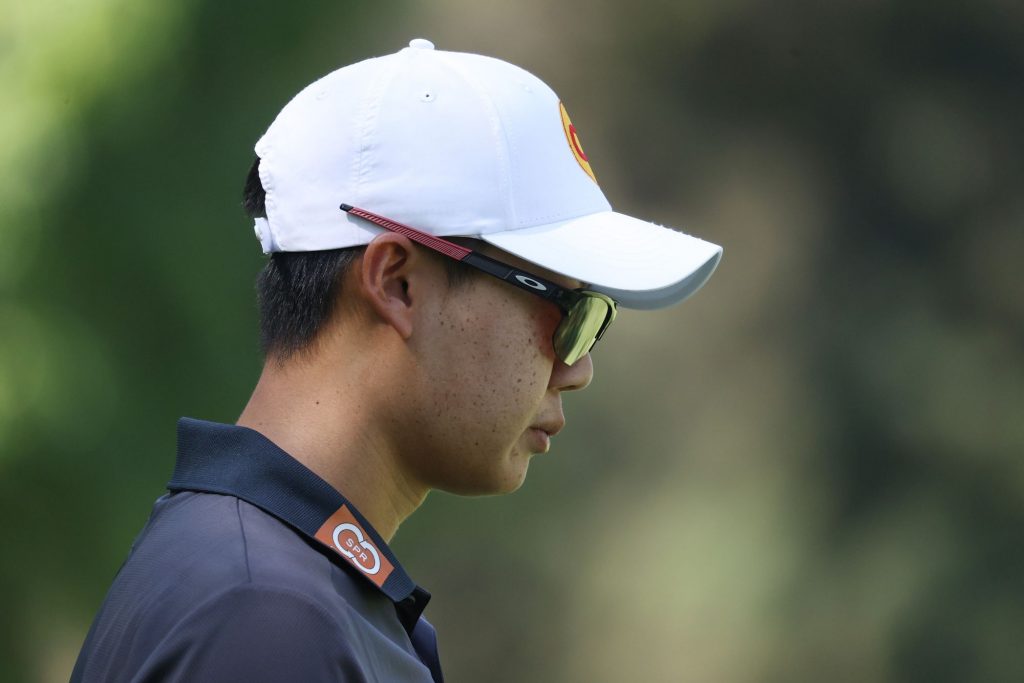
Sentosa, Singapore May 27: Reigning Asian Tour Order of Merit champion Jazz Janewattananond of Thailand is itching to get back onto the tee and reignite his American dream.
Fuelled by an unprecedented sporting shutdown which saw him seek refuge in Orlando over the past two months, the 39th ranked golfer in the world will be amongst the stars returning to action at the Charl Schwab Challenge when the PGA TOUR resumes play on June 11 under a new Health and Safety Plan.
Jazz is slated to feature in other tournaments including the RBC Heritage, The Memorial Tournament and WGC-FedEx St Jude Invitational, appearances he hopes will help him secure membership on the PGA TOUR. He can also look forward to three of the four majors in the reimagined 2020 schedule.
“I might be seeking asylum here,” joked Jazz in a telephone interview.
“These next few events … it’s going to be great. I won’t really care what I shoot honestly, I just want to play tournament golf again. I’ve got a few other events lined up and my team is asking for invites. I’m lucky we get to play golf again as every tour around the world is closed.”
His American dream, though, has come with some personal sacrifices. He has been away from his close-knit family since late February and opting to remain in the U.S. during the enforced shutdown due to the COVID-19 pandemic was made worse with the death of his grandfather recently.
“I’ve tried to keep the spirit up. It feels like you’re in a tunnel and I’m trying to get to the end of the tunnel. It’s tough when you’re far away from home,” he said.
“A few weeks ago, my grandfather passed away and I was sad I couldn’t be there for my mum and family. I miss them very much but thanks to technology, we Facetime regularly. They are letting me do what I want and reminding me to stay safe and healthy.”

What Jazz wants is to join countryman Kiradech Aphibarnrat on the PGA TOUR as soon as possible. After winning four times in Asia last season to skyrocket up the world ranking, he followed up with a pair of top-five finishes in Hong Kong and Singapore in January before finishing T53 at the WGC-Mexico Championship.
The Thai missed the cut at the Arnold Palmer Invitational at Bay Hill and then shot an opening 76 in THE PLAYERS Championship before the TOUR’s flagship event was cancelled due to the coronavirus.
“I want to have that feeling again, the kind of feeling you get when you’re in competition mode. I won’t say I crave for it but that’s why we play golf. You want to have that feeling,” said the 24-year-old.
While he misses his family dearly, Jazz has inadvertently found comfort through an ‘adopted’ family, thanks to Daniel Chopra, a two-time PGA TOUR winner and Asian Tour regular.
After bumping into Chopra at Bay Hill in the week leading up to the Arnold Palmer Invitational, the Swede invited Jazz to stay with his family and when the shutdown occurred on March 13, Chopra did not hesitate to invite Jazz and his caddie, Camp Pulit, back to his Orlando home to seek refuge.
“When the shutdown happened, I didn’t want to go back to Thailand as we weren’t sure how long the break would last. And then, our country shut down and it was too late to get home. I know Daniel as he plays in Asia but I didn’t realise he lives and practices at Bay Hill. We had a hotel room booked for two weeks but he made us stay with him. It was good to have some familiar faces around … it felt like family.”
His time with Chopra, who has two children Casper and Coco with wife Samantha, has been wonderful. Jazz says he has found renewed vigour for the game and fallen in love with Bay Hill that he took up a club membership. If he secures his PGA TOUR card, Jazz will not hesitate to consider setting up base near the iconic club.
He is thankful the Chopras have helped ease the downtime. “Everything was closed here, except for stuff related to health and groceries. Our daily routine was wake up, think about what I’m going to eat next, stare out of the window, and repeat,” he laughed.
“When golf was restricted, we tried to spice things up in our daily life. We played basketball and Casper would beat us easily. I also spent time wake boarding and wake surfing and Samantha plays tennis so we played a bit to keep active.”
When golf facilities reopened, Jazz and Chopra participated inone-day competitions to get the adrenaline flowing again. “I just miss the travelling and going out to play, meeting new people. We played in several mini tour events … one day, we got up at 5am, drove for two hours to the course and teed up. I shot one-under in the first event and didn’t make my money back (from the entry fee) and in the second one, I shot two-under and tied Daniel in third place.”
The 46-year-old Chopra, who is of Indian-Swede parentage, won his first PGA TOUR event at the 2007 Ginn sur Mer Classic and two events later claimed the season-opening 2008 Sentry Tournament of Champions, beating Steve Stricker in a playoff.
Jazz has closely watched and learned from the Swede while practising together and also picked the brains of other PGA TOUR winners including Robert Damron and Dicky Pride during social rounds together.
“Daniel has a golf net at home and I’ve been grinding. We’ve played golf almost every day together and Daniel’s a great guy and a great golfer. He loves a side game and when he needs to make a putt, it just comes up for him. I guess that’s why he’s a PGA TOUR winner. Casper, who is 10, is a good golfer too. I wasn’t as good as him when I was his age and he would hit balls all day long. I consider myself a range rat but he’s out-practising all of us. It kind of gives us a boost for our love towards golf. It’s a good reminder,” said Jazz.



With international travel and requirements differing from one country to another, Jazz is looking at extending his visa to remain in the U.S. beyond its current expiration in August. With the U.S. Open slated in September and Masters Tournament in November, he is keeping his options open to staying on in the country for remainder of the year.
“If I go back to Thailand, I don’t know if we’ll have to go through quarantine or if it’ll be easy to return to the U.S. I’m happy here so maybe it’ll be better to stay on. No one expected this to happen in our lifetime. You’re just moving along and then this happens. A lot of people are more united and helping each other out and I think humanity will come out on the better side of this.
“For Daniel and Samantha to open up their home to me and my caddie, they have helped me out so much. You see the nicer part of people and the best of people coming out to help one another.”
Ends.



May 21: The U.S. Open, according to most golfers is the toughest Major to win. On the tournament Thursday, it has 156 starters, but in the weeks running up to it, it has more than 10,000 dreamers hoping to get to that starting line, writes V.Krishnaswamy, @Swinging_Swamy one of India’s leading sports journalists.
But this year, with Covid-19 looming large, the United States Golf Association (USGA), has announced there will no qualifiers at all. The tournament, scheduled to be held in June has been shifted to September.
The qualifiers have been a route for many an Indian seeking to play the U.S. Open. As many as six Indians have figured in the U.S. Open, with Jeev Milkha Singh, like in many other aspects being the first. And all of them have come through the qualifiers at least once. Only Singh (in 2007 and 2009) and Anirban Lahiri (2015 and 2016) had direct exemptions, but on other occasions, they, too, came through the world-famous qualifiers.
Singh ‘qualified’ through Final qualifiers for his first U.S. Open in 2002 at Bethpage. After that he played the U.S. Open four times more. In 2006 and then again in 2017, too, he came through the qualifiers.
In 2016, he was actually the first alternate at the end of the qualifiers in Surrey, but got in after the withdrawal of Thongchai Jaidee.
In 2007 and 2009, he played because he was inside top-50 at the end of the previous year. He ended 2007 as world number 37 and was ranked 35th the end of 2008, winning the Asian Tour Order of Merit that year too.
“For me, the toughest Major is the U.S. Open, though the Masters was always a dream, like it is for any golfer. The qualifiers for the U.S. Open are tougher than most events and it takes a lot out of you. I am proud of the three times I came through that route and twice by exemption,” said Singh on the cancellation of the U.S. Open qualifiers.
“The massive scale of the qualifiers, often with over 10,000 starters is what make the U.S. Open so unique and it is called the People’s Major. Alas COVID-19 has stopped that from happening this year. But I am sure it (the qualifiers) will be back next year and I hope I will be there at the starting line.”
In 2006, along with Singh, another Indian getting into U.S. Open field was Jyoti Randhawa, also getting in through qualifying event in Surrey.



PEBBLE BEACH, CA – JUNE 14: Arjun Atwal of India (2nd L), Dustin Johnson (2nd R) and Tiger Woods (R) walk together during a practice round prior to the start of the 110th U.S. Open at Pebble Beach Golf Links on June 14, 2010 in Pebble Beach, California. (Photo by Ross Kinnaird/Getty Images)
In 2010, Arjun Atwal became the third Indian to play the U.S. Open after coming through qualifiers at Rockfort, U.S.
Shiv Kapur, who loves the challenge of qualifiers, has played five Majors and each time he came through the qualifiers. Three times he did that for The (British) Open – in 2006, 2013 and 2016. Twice he got into the U.S. Open by the same route – in 2014 and 2015.
“What a pity, there will be no qualifiers this time. The Open is cancelled and the US Open has cancelled the qualifiers. But I suppose there was no choice. For me, the qualifiers have meant a lot. I made the Majors four times in five years through qualifiers between 2013 and 2017,” said Kapur, who logged his Major result, tied-23rd at the 2014 U.S. Open.
“The qualifier is a massive challenge and the 36-hole attempt has no room for error,” he added.
Shubhankar Sharma’s magnificent 2018 season saw him get an invite to the Masters, but for the U.S. Open he had to qualify from Columbus, and he did.



OAKMONT, PA – JUNE 17: Anirban Lahiri of India hits his tee shot on the 12th hole during the continuation of the weather delayed first round of the U.S. Open at Oakmont Country Club on June 17, 2016 in Oakmont, Pennsylvania. (Photo by Ross Kinnaird/Getty Images)
In 2019, Lahiri, came through the qualifiers for his third appearance at the US Open. In 2015, when Lahiri won the Hero Indian Open, his last pro title, he forced his way into Top-50 before the U.S. Open. He ended 2015 at 40th in the world, making him eligible for 2016 U.S. Open.
“As you can imagine, this was an incredibly difficult decision, as qualifying is a cornerstone of USGA championships,” said USGA senior managing director of championships John Bodenhamer.
Ends.



Sentosa, Singapore May 21: It has been more than two months since the last putt dropped at the Bandar Malaysia Open.
Trevor Simsby’s euphoric celebrations that reverberated across Kota Permai Golf and Country Club after winning his biggest professional title seemed like a distant memory now.
That was the last slice of action on the Asian Tour before the COVID-19 virus sent the world into a tailspin.
The buzz around the golf course is missing, the euphoria of the crowd cheering in unison as the ball drops into the hole is gone and professional men’s golf is now on hold.
It has been an eerie silence but like the sporting spirit which speaks of resilience, many are adjusting to their new normal.
While some are in isolation at home, others like Kiradech Aphibarnrat and Danny Chia braved the long wait to get home before serving their mandatory 14-day quarantine in hotel rooms designated by their respective local governments.
Chia was left stranded in Japan for almost two months after his plans to arrive early for the Abema TV Tour was thwarted by the invisible virus.
Although he could still enjoy his rounds of golf in the Land of the Rising Sun, it was the yearning of being back with his family and friends that was foremost on his mind as ‘nothing beats the feeling of being close to your loved ones.’
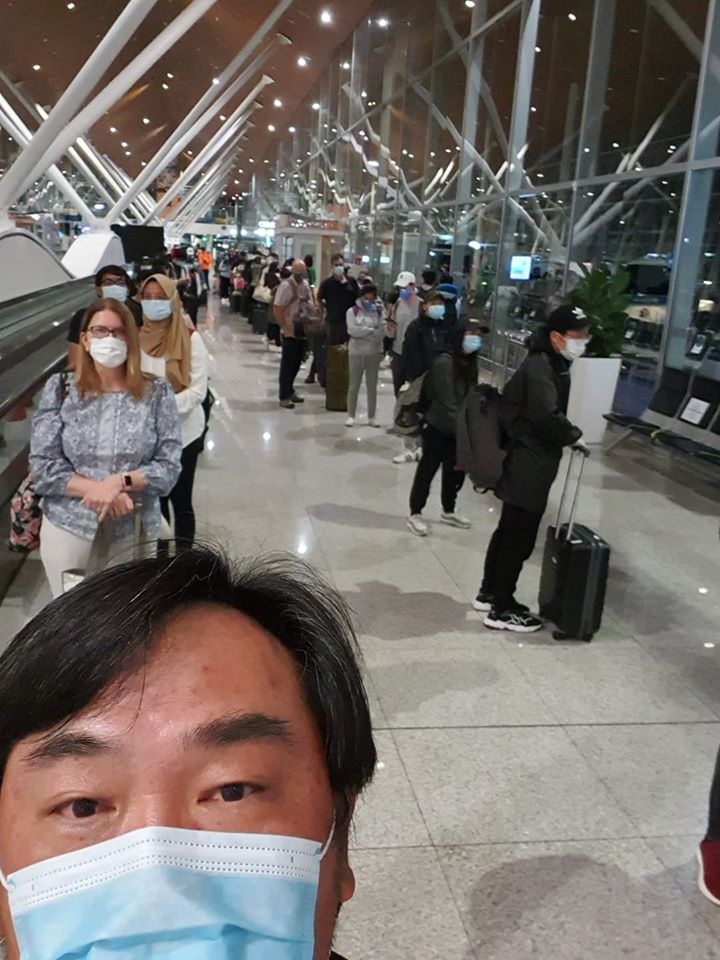


Kiradech’s time in isolation and away from the family has been a good time for reflection, seeing how life sometimes need to be looked at from a different angle.
“This is like a life lesson. It puts a lot of things in perspective and how important it is to keep not only yourself safe but also your family. When we were in Orlando, it was scary to go out to meet friends as we were afraid of passing the virus. Everyone has to be safe. It makes you appreciate life and golf more,” said the 2013 Asian Tour Order of Merit champion.
India’s Anirban Lahiri and Malaysia’s Nicholas Fung are attempting to become the next MasterChef while others like David Gleeson is filling his social media pages with display of his musical talent, mimicking Sir Nick and The Hawk. Justin Harding, Rahil Gangjee and Aman Raj are experimenting with new fashion styles and reigning Order of Merit champion Jazz Janewattanond is discovering another skill.
Practice sessions have been quickly adapted in homes, some even with home-made golf simulators to keep themselves fit and ready for whenever it is time to return to some semblance of normality.
Although Mardan Mamat can no longer share the same physical space with his fans, digital advancements have enabled him to see and talk to them, dispensing (free!) golf tips from home.
Daniel Chopra has even taken time to take everyone on a grand virtual tour of his home in Orlando.
Time has opened for different things and brought many closer together to those that they live with.
Chiragh Kumar continues to fill the hours playing with his kids, spending time at home and waiting like everyone else to see what’s next.
While many are enjoying the comforts of home during these times, some like Japan’s Yuta Ikeda is preparing to make his long-awaited trip home after spending more than two months in Malaysia after coming down with dengue fever and not being able to return to Japan earlier due to travel restrictions.
The route to normality is still hazy with signpost shifting like pin positions but golf will be back.
The days in quarantine will be over.
Friends will step out from behind their screens and meet as rivals on the golf course again.
We will travel again.
Life on the Asian Tour will go on, as it always has and as it always must.
Ends.



Sentosa, Singapore: May 20: To paraphrase the timeless classic from the Beatles, “Will golf still need me, when I am 64?”
When it comes to Boonchu Ruangkit of Thailand, who celebrated his 64th birthday earlier this month, the answer is emphatically ‘yes’.
Kiradech Aphibarnrat, the only Thai to have secured a full card for the PGA Tour, was among those thanking Boonchu for his guidance over the years on the occasion of his birthday.
On Facebook, Kiradech posted a picture of himself and Boonchu and wished the veteran good luck and good health in the future.
Also, he said that Asian golf was missing a role model like Boonchu on tour.
Make no mistake about it, Boonchu – a proven winner with a lovely, languid swing and an easy manner – was the eminence grise for players of many nationalities, not just Thais.
At tournaments, golfers would gather round him on the practice range, putting green and clubhouse such is his charisma, ability and knowledge of the game and of the vagaries of life.
And, typical of the man, he was always willing to lend an ear, impart words of wisdom and, even, offer a tip or two on putting and chipping, the cornerstones of his game.
Boonchu will always be linked with the Asian Tour, not least because he struck the opening drive when the new player-centric circuit was launched at the Thailand Open in 2004.
Not someone who does things by half, he went on to win his national Open for the second time, an achievement that gives him great joy to this day.
For the record, Boonchu hit the historic first shot at 7.00 am on Thursday, January 22, 2004 with playing partners Thongchai Jaidee, the Thai whose star was just starting to rise internationally, and gifted Korean Kang Wook-soon, looking on at the Royal Thai Air Force Golf Club.
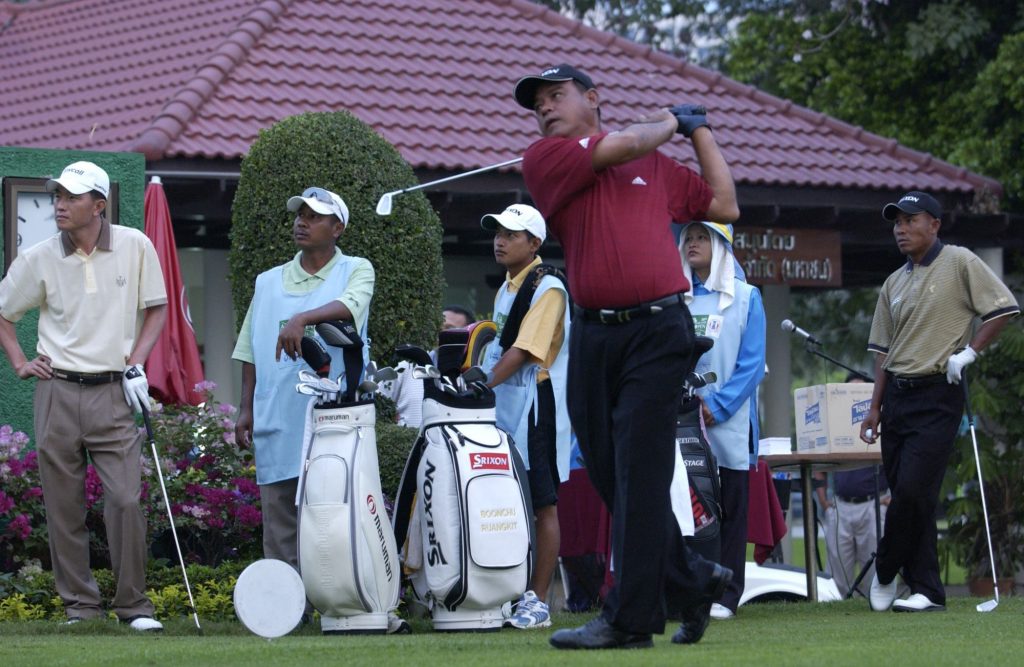


Kang, keen to win the tournament to make up for missing his US PGA Tour card by a stroke at qualifying school the previous month, upstaged Boonchu in the first round by shooting a 63, five shots better than the Thai.
He maintained the lead over the next two rounds and held a one-stroke advantage over fellow Korean Kim Jong-duck heading into the Sunday showdown with Boonchu trailing by three.
That changed quickly with Boonchu opening the final round brightly with birdies at the first two holes and made up for a bogey at the fourth hole with further birdies at the fifth, seventh and 10th holes.
Meanwhile, Kang carded three bogeys and a double bogey in the first nine holes to fall out of contention.
After missing a short par putt at the 17th, Boonchu birdied the last to secure victory by two shots over Kim and Thailand’s Prayad Marksaeng.
“I took the lead at the 10th hole and after that I played cautiously. When I hit my approach shot at the 18th, I knew I had won – it was a great feeling,” said Boonchu, who also won the Thailand Open in 1992, at the time.
“This is the greatest moment of my career. I hit the first drive in 1995 to launch the (former) Tour and hit the first drive this week. It is special to win your home Open and now I have won it twice.”
While Boonchu collected the plaudits and a cheque for US$48,450, a lesser light also recorded an amazing feat that is unlikely to be repeated in world golf.
Chen Chung-cheng of Chinese Taipei shot two aces…at the same hole.
Sadly, he walked away with nothing to show for the incredible double.
The 27-year-old aced the 187-yard fourth hole during the first round and repeated the feat in the third round.
A condominium and a car were on offer at two other par-three holes at the Royal Thai Air Force club but there was no prize for holing in one at the fourth
“No car keys, again,” laughed Chen. “I cannot believe I holed in one at the same hole. When I hit my four iron, I thought it was going to be close but I did not see it go in the hole.
“Tomorrow I will be trying hard to hole-in-one at the eighth (where the condominium was on offer).”
Korean Jun Chul-yoo had better luck than Chen. He was rewarded with a car for his ace at the 13th hole during the second round.
With Boonchu’s remarkable win, a double ace and a feast of low scoring, the tone was set for the new Asian Tour and the circuit has continued to produce the magic that makes top level golf so watchable.
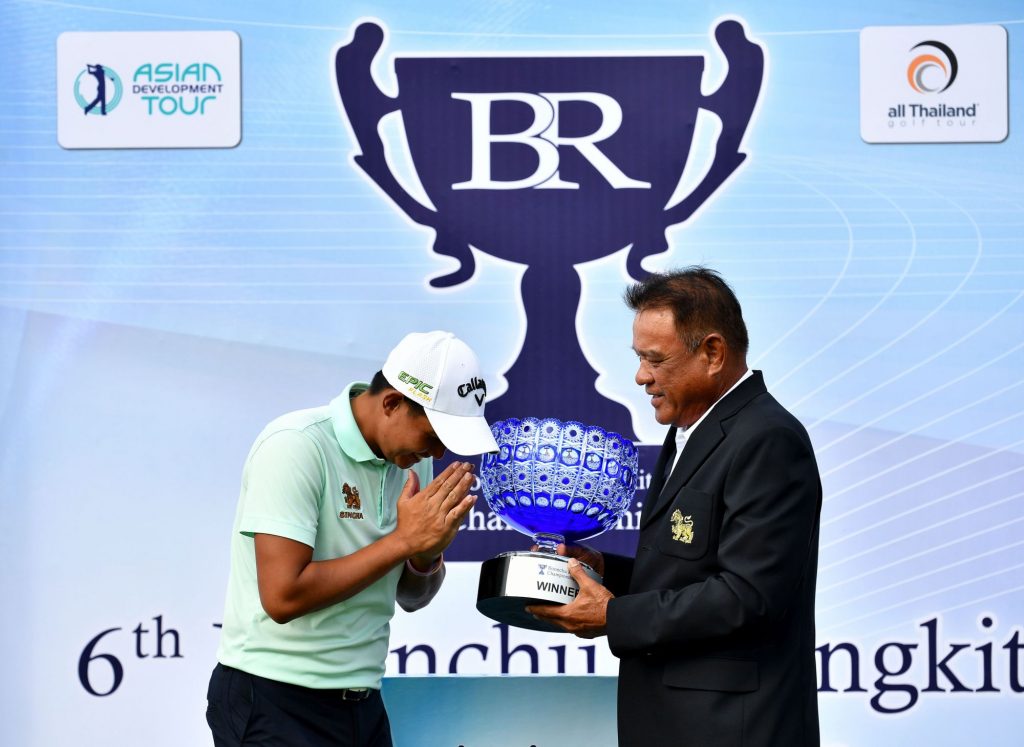


NAKHON RACHASIMA-THAILAND – The Boonchu Ruangkit Championship at the Rancho Charnvee Resort & Country Club, Nakhon Rachasima, Thailand, Sunday January 26, 2020. The approximate USD$ 130.000 event is the 1st event on the 2020 Asian Development Tour. Picture by Paul Lakatos/Asian Development Tour.
Fast forward to more recent times and Boonchu is still having an impact on Asian golf.
He has hosted the Boonchu Ruangkit Championship on the Asian Development Tour since 2015, the most recent of which in January this year attracted a strong field, including Thai stars Thongchai Jaidee and Prayad Marksaeng, and was won by Boonchu’s countryman, the talented Pavit Tangkamolprasert.
Ends.



Sentosa, Singapore, May 19: Last year India’s Rashid Khan staged one of the best comebacks of anyone on the Asian Tour although the only thing missing to validate that was the big ‘W’.
After five straight seasons of finishing inside the top-60 on the Asian Tour Order of Merit, two-time winner Khan hit a lean patch in 2018. While he had made the cut in 11 out of 19 events played, no top-10s during the season meant he made just over US$44,000 and lost his card by finishing 81st in the rankings.
Playing the 2019 season on a country exemption offered Khan no starts in the big co-sanctioned events early in the season he had gotten used to playing in, but he took advantage of a spot in his national Open by finishing tied-10th in the Hero Indian Open in late March.
He quickly followed this good result up in Bangladesh the following week, having a chance to win the Bangabandhu Cup Golf Open on the back-nine in the final round. He would eventually finish in third place two strokes behind the winner.
During his full 2019 Asian Tour season, Khan played 11 events and finished in the top-10 six times, highlighted by a tied-second in the Classic Golf and Country Club International Championship on home soil, and easily kept his card banking over US$140,000 in the process.
He has also started his 2020 campaign in great fashion, posting a sixth and tied-eighth at the Hong Kong Open and SMBC Singapore Open respectively, and currently sits in 10th place on the Order of Merit.
So, which asepcts of Khan’s game has brought him back to be in contention to win tournaments again after losing his card two seasons ago?
Driving
Improving his Driving Accuracy from just over 55% in 2018 to 69% last year meant Khan was able to hit his approach shots from the fairway twice more per round. Combined with an increase in distance of 7.55 yards, this would have set him up nicely to make big improvements in other categories as well.
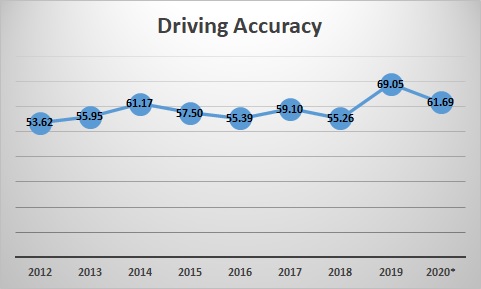


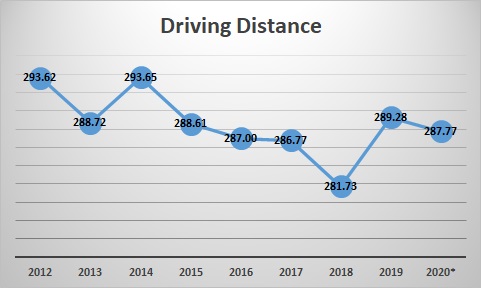


Greens-in-Regulation (GIR)
Possibly as a result of hitting two more fairways per round and a bit longer off the tee, Khan also made big improvements to his GIR percentage going from hitting 10.47 greens per round to 12.69 in 2019. An increase in just over two greens per round will certainly help anyone’s game, by giving you more opportunities to putt for birdies.
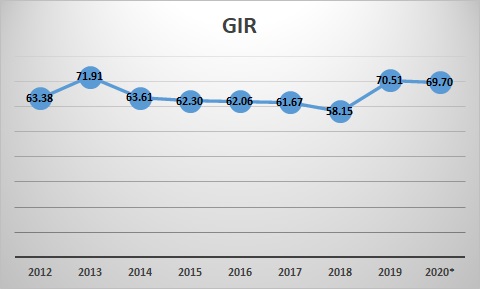


Birdies per Round
Khan made almost one birdie more per round in 2019 compared to the year before and finished tied-sixth in average birdies-per-round on the Asian Tour last season. It should also be noted that he was third in bogey-avoidance with 2.03 per round, a combination that will be very good for your scoring average.
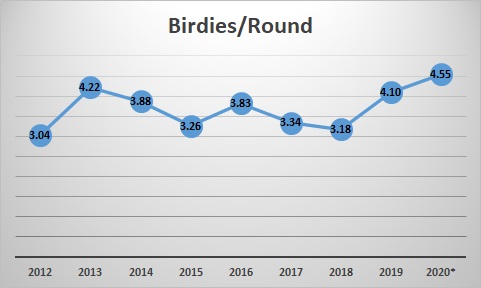


Scoring Average
Making lots of birdies while keeping bogeys to a minimum put Khan in second place in the Scoring Average category, only Order of Merit winner Jazz Janewattananond was better during the 2019 Asian Tour season.
Even though it is very early in the 2020 season due to the COVID-19 pandemic with limited rounds played so far, Khan seems on track to continue his comeback when the season resumes again.
Ends.



Sentosa, Singapore May 13: The Asian Tour season might have hit the pause button due to the global COVID-19 pandemic. But that does not stop us from gazing into the crystal ball to pick out likely members who might enjoy their breakthrough on Tour when the season resumes.
Phachara Khongwatmai (Tha)
Phachara Khongwatmai, whose name in Thai means ‘Diamond’ is raw gem,has continued to sparkle in many ways since he burst onto the scene as a wide-eyed 14-year-old, winning a professional golf tournament in 2013.
He would go on to become the youngest winner on the Asian Development Tour at the age of 15 when he won the 2015 PGM CCM Rahman Putra Championship.
At 21 now, Phachara has never been in better form in the last few couple months before the COVID-19 halted play. In his last four events of 2019, Phachara never finished lower than tied-sixth, with two tied-seconds in the Thailand Masters and Sabah Masters as his best results.
He also managed to strike a formidable partnership with Thai legend, Thongchai Jaidee when they won the GolfSixes Cascais in Portugal, a two-player team event on the European Tour in June.
The Thai started his season at the Hong Kong Open with a tied-22nd finish before following it up with a tied-65th result at the SMBC Singapore Open.
He showed he was ready to challenge for his first Asian Tour victory when he secured a tied-seventh finish at the Bandar Malaysia Open, which would be the last event on the Asian Tour before the season came to a halt.
Scott Vincent (Zim)



Scott Vincent is the first Zimbabwean to play on the Asian Tour and charting a course on the Asian Tour for his compatriots to follow.
While he may have notched his first professional win on the AbemaTV Tour in Japan last year, it will be a breakthrough on the Asian Tour that he will be eyeing.
Having made his debut on the Tour in 2016, Vincent has finished second on five occasions. His dreams of entering the winner’s circle are often dashed at the last minute. But even in defeat, the ever-gracious Zimbabwean has always accepted it may not be his day and he probably have to bid for their time a little longer.
He has often said he is ‘getting very close to winning for sure,” and we can be sure to bet on that to come true soon.
Travis Smyth (Aus)



The lanky Australian has made great progress since he earned his Asian Tour card through Qualifying School in 2018. It was also in that same rookie year that Travis Smyth came closest to winning when he finished seventh at the Shinhan Donghae Open.
Since then, Smyth has gone on to establish himself as a genuine contender, coming close again this year at the Hong Kong Open and SMBC Singapore Open where he finished tied-13th and 11th respectively.
Although he now spends his time in isolation, offering free tips to golfers over social media apart from keeping fit and staying sharp, Smyth could be dispensing winning tips next when he returns to the tee.
Gunn Charoenkul (Tha)



Even as he enjoys his well-deserved family time with his new-born daughter now, Gunn will be ready to come out with all guns blazing when the season resumes.
In all his events played in 2019 that were Official World Golf Ranking (OWGR) events, Gunn posted 19 top-10 finishes across all Tours. He may not have made his breakthrough on the Asian Tour but his consistently was certainly there for all to see.
Gunn continued where he left off early this year with an outright third place at the Hong Kong Open followed by a tied-14th and tied-13th finish at the SMBC Singapore Open and Bandar Malaysia Open respectively.
Despite not ending up with a grandstand finish, Gunn still holds a very strong sense of self-belief as he ‘would rather be very consistent throughout the year than win one and then not perform at all.
He knows he needs to be stay patient and ‘when it’s time (his win), it’s going to come.” Words that might prove prophetic if he continues to play true to form.
Ends.



Sentosa, Singapore, May 12: For three days, Brad Kennedy was largely out of the radar at the 101st New Zealand Open presented by Sky Sport.
Even as a 17-year-old Korean whiz kid, Joohyung Kim hogged the spotlight after holding the lead for three rounds, the Australian was already plotting his way back to lifting the New Zealand Open trophy again.
The 45-year-old last held aloft the prized trophy in 2011 and showed that his vast years of experience still counts over his younger rivals even as he contemplates putting aside his golf clubs for good.
The global COVID-19 pandemic may have temporarily disrupted the Asian Tour season, but it does not stop us from revisiting Kennedy’s moment of glory at the Millbrook Resort in March.
By Brad Kennedy
I just ground it out and really tried to play within my game as much as I could. I just let my putter do the talking today and I’m just relieved, and to do this again after nine years is just unbelievable.
I didn’t look at a leader board all day. I actually posted a number in my head last night, 21 was the number, and I didn’t think I would be able to reach it. But I just knew that this course was out there to be had and it was playing unbelievable.
I was gutted after the Queensland PGA and Open last month (February) and I actually didn’t want to play as I was that mentally destroyed by what happened. To do that today under that sort of pressure and overcome that, I’m just really proud of myself.
I have always said 2020 would be my last year. I’ve been playing 25 years on Tour and it was time to get home and spend some more time with my kids and wife. But who knows now? If I can still do it at 45 then I don’t know what’s going to happen.
Ends



Sentosa, Singapore, May 11: It took an agonizing wait at the clubhouse and three trips down the down the 18th hole at the Kota Permai Golf and Country Club before Trevor Simsby secured his Asian Tour breakthrough at the Bandar Malaysia Open in March.
The taste of success was especially sweet for the American whose golfing journey has been met with lots of trials and tribulations along the way.
Leaving his ‘comfort zone” and home in California, Simsby came through the 2019 Qualifying School and plied his trade on both the Asian Tour and the ADT last season. He finished 84th on the 2019 Asian Tour Order of Merit to miss out on his playing rights for 2020 but a seventh-place finish on the ADT Merit rankings last season saw him regain his Asian Tour card for 2020.
Simbsy’s biggest professional victory in the Malaysian capital looked set to kickstart his career until the global COVID-19 outbreak put a pause to many of his well laid out plans. Until he steps back to the tee again, Simsby took some time off to reflect on his glorious moment in Kuala Lumpur with Olle Norberg, a former Asian Tour and European Tour professional.
Ends
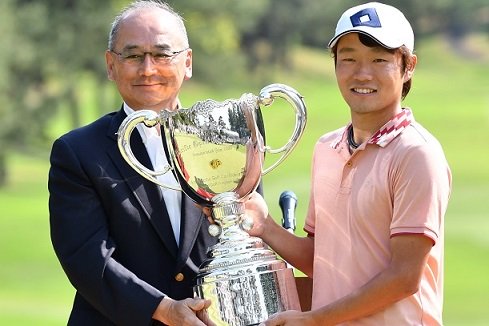


Tokyo, May 11: The 2020 Asia-Pacific Diamond Cup may not feature on the schedules of the Asian Tour and Japan Golf Tour Organisation (JGTO) this year due to the COVID-19 pandemic.
But it is still worth knowing that while the Asia-Pacific Golf Confederation (APGC) boasts many jewels in its tournament crown, few have shone quite so brightly as the Asia-Pacific Diamond Cup, writes Spencer Robinson.
A high-profile professional championship that is co-sanctioned by the Asian Tour and JGTO, to say the Diamond Cup is steeped in history and tradition is an under-statement.
Dating back to 1969, the Diamond Cup has endured changes, challenges and hardships over the course of the past five decades.
Its past may be clouded in complications but the fact that it continues to stand proud and strong is, first and foremost, a testament to the wherewithal and unstinting support of the Japan Golf Association (JGA), the glue that has held this remarkable tournament together.
In an ever-changing world, the JGA has been the one constant as the tournament has evolved through a plethora of guises, title-sponsorships, mergers, reincarnations and partnerships, remaining as one of the JGA’s four National Championships, alongside the Japan Open, Japan Women’s Open and Japan Senior Open.
No wonder the Diamond Cup is revered and holds such a special place in the hearts and minds of golfers and golf fans in Japan and around Asia.
Andy Yamanaka, the JGA’s Executive Director and Chief Operating Officer, said: “Given its rich history, the Diamond Cup is truly unique. Over the years, it’s been the intention for the Diamond Cup to contribute to society through a series of charity activities, a commitment to preserve our natural environment as well as focusing on making a regional contribution through the development of junior and amateur golfers.
“The JGA, meanwhile, is proud to be a member of the APGC. As one of the leading golfing countries in Asia, it’s important for us to contribute and give something back to help golf develop around the region. One of those ways is through the Diamond Cup where a number of exemptions are allocated to the APGC for them to invite leading amateurs from the region to participate.”
Taimur Hassan Amin, the APGC’s Chairman, said: “We’re fortunate to have such a special bond with the Japan Golf Association and appreciate all the efforts they make for the betterment of golf, not only in Japan, but across the region. The APGC is especially grateful to them for the generous Diamond Cup gesture. I know our leading players strive to receive an invite and for those that are lucky enough to get it, playing the tournament is one of the highlights of the year.”
Inaugurated as the Dunlop Tournament, it has in the ensuing 51 years, been variously called Mitsubishi Galant Tournament, Mitsubishi Motors Tournament, Diamond Cup Tournament, Mitsubishi Diamond Cup Golf, Diamond Cup Golf and, since 2014, the Asia-Pacific Open Golf Championship Diamond Cup Golf.
Past champions include dozens of legendary figures including Japanese all-time greats Masashi ‘Jumbo’ Ozaki, Tsuneyuki ‘Tommy’ Nakajima and Isao Aoki and Major champions Peter Thomson and Todd Hamilton.



In 2013, a rising star of world golf named Hideki Matsuyama was added to the roll of honour. A two-time winner of the Asia-Pacific Amateur Championship (AAC), Matsuyama turned professional in April that year and won his second professional tournament, the Tsuruya Open. Five weeks later, at the start of June, Matsuyama triumphed by two strokes in the Diamond Cup.
From an APGC perspective, the success of Matsuyama was especially poignant, not only given his AAC triumphs but also because the Confederation’s links with the JGA go all the way back to the early 1960s and the formation of the Asia Golf Circuit (AGC), conducted under the auspices of the APGC.
Staged in the first quarter of 1962, the inaugural AGC schedule was made up of the national Open championships of the Philippines, Malaysia, Singapore and Hong Kong with the Yomiuri Kokusai (International) Open in Japan acting as the concluding leg.
With the Japan Open traditionally held later in the year, the JGA, one of the founding members of the APGC, created the Yomiuri Kokusai Open specially to join the AGC. As part of the arrangement, it was agreed that the APGC would be allocated a number of exemptions for leading amateurs from member nations.
In 1973 the Yomiuri Kokusai Open was replaced by the Sobu Kokusai (International) Open which, in turn, was replaced on the AGC by the Dunlop International Open in 1977. That morphed into the Dunlop Open in 1990 until Kirin Beer assumed title-sponsorship in 1996 with the event being renamed as the Kirin Open, which became the Asia Pacific Open Golf Kirin Open in 2000. It was held for the final time in 2001 when Shingo Katayama made a successful title defence.
In challenging economic times, it proved impossible to find a backer until the Asia-Pacific Open Golf Championship Panasonic Open was launched in 2008.
Meanwhile, the Diamond Cup had been founded in 1973 and travelled throughout Japan with different courses hosting the event on all four major islands. In 2004, it became the Mitsubishi Diamond Cup, returning to Diamond Cup Golf in 2010.
And so it remained until 2014 when there was a marriage between the Diamond Cup Golf and Asia-Pacific Open Golf Championship. Under guidance from the JGA, the two events merged into the Asia-Pacific Open Golf Championship Diamond Cup Golf, in partnership with the Mitsubishi Corporation and Osaka-based Kansai Television Co Ltd. Adding to its prestige and kudos, the Diamond Cup was recognised by The R&A last year with the enticement of an invitation to the champion to compete in The Open.
Although the seventh edition – originally scheduled to take place from May 7-10 – has been cancelled due to the Covid-19 pandemic, Yamanaka is bullish for the future of the event.
He said: “The Asia-Pacific Open Golf Championship Diamond Cup Golf has a remarkable past and we are committed to ensuring it has a glittering future. We look forward to the tournament returning to the calendar in 2021 – better and stronger than ever.”
Ends.



Sentosa, Singapore, May 6: In his maiden visit to Singapore for the SMBC Singapore Open, American Matt Kuchar not only drew the crowds to the Sentosa Golf Club but also gave everyone a lesson on mental fortitude.
With a commanding four-shot lead before stepping up to the 587 yard par-five seventh hole, Kuchar would have his advantage instantly wiped out with a triple-bogey eight on the same hole which he had breezed through easily with an eagle, birdie and birdie in his first three rounds.
The American showed tremendous resilience though to recover as he fired three birdies over the next 11 holes to win the iconic Singapore showpiece which would have been the second of the four events played on the Asian Tour before the global COVID-19 pandemic disrupted the season.
We revisited that glorious Sunday for Kuchar and hear what he had to say about his victory in Singapore again.
By Matt Kuchar
Golf and life have a lot of similarities. When you face difficult times, it’s how you persevere and overcome those things.
To make a great turnaround and play a great back nine to close out the tournament with birdies on the 16th and 18th was a real thrill
I’m awfully proud of being able to bounce back from adversity and not let hard things get the better of me.
Seven was a disastrous hole to make triple bogey there. I felt like I was cruising along and had a four-shot lead at that point and it was awfully comfortable. I played a tee-shot that I thought was a conservative shot, just a little up the left side, and it ended up finding its way between a few trees.
I swung and missed as the ball was wedged among the roots and then I had to step up and actually try to swing and hit that ball on the next shot. I got it out but the next one hits the cart path and goes into the leaves and I have to take a penalty drop.
I finally managed to put it on the green where I had to line up an 80-footer up to 10 feet for a triple knowing that Jazz is about to make birdie. And if he made that birdie, I would need to make triple just to tie with him.
That 10-footer was a big, big putt to make. A 10-footer is an easy one to miss and a great putt to make. It was a bit of a wake-up call as I was playing good golf then and all of a sudden you’re all square.
There was another par-five on the 18th where I was playing conservative with the water on the left. My ball went to the right and found the bunker which I thought was a fine place to be. But I could only play a standard greenside blast out of the bunker and was faced with a shot of about 230 yards. I knew I only needed a bogey to win and of course I hit a fantastic shot to about 20-feet.
There are certainly a lot of great players here on this Tour, so it feels fantastic to come out on top.
It’s fantastic to travel around the world and come to a great city like Singapore. I had the chance to play a great golf course and also test my game against some great, great players that we don’t often see in the United States.
Ends


Jazz keen to strike happy tune when golf returns
By - ocssoftware
[addtoany]


Sentosa, Singapore May 27: Reigning Asian Tour Order of Merit champion Jazz Janewattananond of Thailand is itching to get back onto the tee and reignite his American dream. Fuelled by an unprecedented sporting shutdown which saw him seek refuge in Orlando over the past two months, the 39th ranked golfer in the world will be amongst […]
Sentosa, Singapore May 27: Reigning Asian Tour Order of Merit champion Jazz Janewattananond of Thailand is itching to get back onto the tee and reignite his American dream.
Fuelled by an unprecedented sporting shutdown which saw him seek refuge in Orlando over the past two months, the 39th ranked golfer in the world will be amongst the stars returning to action at the Charl Schwab Challenge when the PGA TOUR resumes play on June 11 under a new Health and Safety Plan.
Jazz is slated to feature in other tournaments including the RBC Heritage, The Memorial Tournament and WGC-FedEx St Jude Invitational, appearances he hopes will help him secure membership on the PGA TOUR. He can also look forward to three of the four majors in the reimagined 2020 schedule.
“I might be seeking asylum here,” joked Jazz in a telephone interview.
“These next few events … it’s going to be great. I won’t really care what I shoot honestly, I just want to play tournament golf again. I’ve got a few other events lined up and my team is asking for invites. I’m lucky we get to play golf again as every tour around the world is closed.”
His American dream, though, has come with some personal sacrifices. He has been away from his close-knit family since late February and opting to remain in the U.S. during the enforced shutdown due to the COVID-19 pandemic was made worse with the death of his grandfather recently.
“I’ve tried to keep the spirit up. It feels like you’re in a tunnel and I’m trying to get to the end of the tunnel. It’s tough when you’re far away from home,” he said.
“A few weeks ago, my grandfather passed away and I was sad I couldn’t be there for my mum and family. I miss them very much but thanks to technology, we Facetime regularly. They are letting me do what I want and reminding me to stay safe and healthy.”



What Jazz wants is to join countryman Kiradech Aphibarnrat on the PGA TOUR as soon as possible. After winning four times in Asia last season to skyrocket up the world ranking, he followed up with a pair of top-five finishes in Hong Kong and Singapore in January before finishing T53 at the WGC-Mexico Championship.
The Thai missed the cut at the Arnold Palmer Invitational at Bay Hill and then shot an opening 76 in THE PLAYERS Championship before the TOUR’s flagship event was cancelled due to the coronavirus.
“I want to have that feeling again, the kind of feeling you get when you’re in competition mode. I won’t say I crave for it but that’s why we play golf. You want to have that feeling,” said the 24-year-old.
While he misses his family dearly, Jazz has inadvertently found comfort through an ‘adopted’ family, thanks to Daniel Chopra, a two-time PGA TOUR winner and Asian Tour regular.
After bumping into Chopra at Bay Hill in the week leading up to the Arnold Palmer Invitational, the Swede invited Jazz to stay with his family and when the shutdown occurred on March 13, Chopra did not hesitate to invite Jazz and his caddie, Camp Pulit, back to his Orlando home to seek refuge.
“When the shutdown happened, I didn’t want to go back to Thailand as we weren’t sure how long the break would last. And then, our country shut down and it was too late to get home. I know Daniel as he plays in Asia but I didn’t realise he lives and practices at Bay Hill. We had a hotel room booked for two weeks but he made us stay with him. It was good to have some familiar faces around … it felt like family.”
His time with Chopra, who has two children Casper and Coco with wife Samantha, has been wonderful. Jazz says he has found renewed vigour for the game and fallen in love with Bay Hill that he took up a club membership. If he secures his PGA TOUR card, Jazz will not hesitate to consider setting up base near the iconic club.
He is thankful the Chopras have helped ease the downtime. “Everything was closed here, except for stuff related to health and groceries. Our daily routine was wake up, think about what I’m going to eat next, stare out of the window, and repeat,” he laughed.
“When golf was restricted, we tried to spice things up in our daily life. We played basketball and Casper would beat us easily. I also spent time wake boarding and wake surfing and Samantha plays tennis so we played a bit to keep active.”
When golf facilities reopened, Jazz and Chopra participated inone-day competitions to get the adrenaline flowing again. “I just miss the travelling and going out to play, meeting new people. We played in several mini tour events … one day, we got up at 5am, drove for two hours to the course and teed up. I shot one-under in the first event and didn’t make my money back (from the entry fee) and in the second one, I shot two-under and tied Daniel in third place.”
The 46-year-old Chopra, who is of Indian-Swede parentage, won his first PGA TOUR event at the 2007 Ginn sur Mer Classic and two events later claimed the season-opening 2008 Sentry Tournament of Champions, beating Steve Stricker in a playoff.
Jazz has closely watched and learned from the Swede while practising together and also picked the brains of other PGA TOUR winners including Robert Damron and Dicky Pride during social rounds together.
“Daniel has a golf net at home and I’ve been grinding. We’ve played golf almost every day together and Daniel’s a great guy and a great golfer. He loves a side game and when he needs to make a putt, it just comes up for him. I guess that’s why he’s a PGA TOUR winner. Casper, who is 10, is a good golfer too. I wasn’t as good as him when I was his age and he would hit balls all day long. I consider myself a range rat but he’s out-practising all of us. It kind of gives us a boost for our love towards golf. It’s a good reminder,” said Jazz.



With international travel and requirements differing from one country to another, Jazz is looking at extending his visa to remain in the U.S. beyond its current expiration in August. With the U.S. Open slated in September and Masters Tournament in November, he is keeping his options open to staying on in the country for remainder of the year.
“If I go back to Thailand, I don’t know if we’ll have to go through quarantine or if it’ll be easy to return to the U.S. I’m happy here so maybe it’ll be better to stay on. No one expected this to happen in our lifetime. You’re just moving along and then this happens. A lot of people are more united and helping each other out and I think humanity will come out on the better side of this.
“For Daniel and Samantha to open up their home to me and my caddie, they have helped me out so much. You see the nicer part of people and the best of people coming out to help one another.”
Ends.



May 21: The U.S. Open, according to most golfers is the toughest Major to win. On the tournament Thursday, it has 156 starters, but in the weeks running up to it, it has more than 10,000 dreamers hoping to get to that starting line, writes V.Krishnaswamy, @Swinging_Swamy one of India’s leading sports journalists. But this year, with […]
May 21: The U.S. Open, according to most golfers is the toughest Major to win. On the tournament Thursday, it has 156 starters, but in the weeks running up to it, it has more than 10,000 dreamers hoping to get to that starting line, writes V.Krishnaswamy, @Swinging_Swamy one of India’s leading sports journalists.
But this year, with Covid-19 looming large, the United States Golf Association (USGA), has announced there will no qualifiers at all. The tournament, scheduled to be held in June has been shifted to September.
The qualifiers have been a route for many an Indian seeking to play the U.S. Open. As many as six Indians have figured in the U.S. Open, with Jeev Milkha Singh, like in many other aspects being the first. And all of them have come through the qualifiers at least once. Only Singh (in 2007 and 2009) and Anirban Lahiri (2015 and 2016) had direct exemptions, but on other occasions, they, too, came through the world-famous qualifiers.
Singh ‘qualified’ through Final qualifiers for his first U.S. Open in 2002 at Bethpage. After that he played the U.S. Open four times more. In 2006 and then again in 2017, too, he came through the qualifiers.
In 2016, he was actually the first alternate at the end of the qualifiers in Surrey, but got in after the withdrawal of Thongchai Jaidee.
In 2007 and 2009, he played because he was inside top-50 at the end of the previous year. He ended 2007 as world number 37 and was ranked 35th the end of 2008, winning the Asian Tour Order of Merit that year too.
“For me, the toughest Major is the U.S. Open, though the Masters was always a dream, like it is for any golfer. The qualifiers for the U.S. Open are tougher than most events and it takes a lot out of you. I am proud of the three times I came through that route and twice by exemption,” said Singh on the cancellation of the U.S. Open qualifiers.
“The massive scale of the qualifiers, often with over 10,000 starters is what make the U.S. Open so unique and it is called the People’s Major. Alas COVID-19 has stopped that from happening this year. But I am sure it (the qualifiers) will be back next year and I hope I will be there at the starting line.”
In 2006, along with Singh, another Indian getting into U.S. Open field was Jyoti Randhawa, also getting in through qualifying event in Surrey.



PEBBLE BEACH, CA – JUNE 14: Arjun Atwal of India (2nd L), Dustin Johnson (2nd R) and Tiger Woods (R) walk together during a practice round prior to the start of the 110th U.S. Open at Pebble Beach Golf Links on June 14, 2010 in Pebble Beach, California. (Photo by Ross Kinnaird/Getty Images)
In 2010, Arjun Atwal became the third Indian to play the U.S. Open after coming through qualifiers at Rockfort, U.S.
Shiv Kapur, who loves the challenge of qualifiers, has played five Majors and each time he came through the qualifiers. Three times he did that for The (British) Open – in 2006, 2013 and 2016. Twice he got into the U.S. Open by the same route – in 2014 and 2015.
“What a pity, there will be no qualifiers this time. The Open is cancelled and the US Open has cancelled the qualifiers. But I suppose there was no choice. For me, the qualifiers have meant a lot. I made the Majors four times in five years through qualifiers between 2013 and 2017,” said Kapur, who logged his Major result, tied-23rd at the 2014 U.S. Open.
“The qualifier is a massive challenge and the 36-hole attempt has no room for error,” he added.
Shubhankar Sharma’s magnificent 2018 season saw him get an invite to the Masters, but for the U.S. Open he had to qualify from Columbus, and he did.



OAKMONT, PA – JUNE 17: Anirban Lahiri of India hits his tee shot on the 12th hole during the continuation of the weather delayed first round of the U.S. Open at Oakmont Country Club on June 17, 2016 in Oakmont, Pennsylvania. (Photo by Ross Kinnaird/Getty Images)
In 2019, Lahiri, came through the qualifiers for his third appearance at the US Open. In 2015, when Lahiri won the Hero Indian Open, his last pro title, he forced his way into Top-50 before the U.S. Open. He ended 2015 at 40th in the world, making him eligible for 2016 U.S. Open.
“As you can imagine, this was an incredibly difficult decision, as qualifying is a cornerstone of USGA championships,” said USGA senior managing director of championships John Bodenhamer.
Ends.



Sentosa, Singapore May 21: It has been more than two months since the last putt dropped at the Bandar Malaysia Open. Trevor Simsby’s euphoric celebrations that reverberated across Kota Permai Golf and Country Club after winning his biggest professional title seemed like a distant memory now. That was the last slice of action on the Asian […]
Sentosa, Singapore May 21: It has been more than two months since the last putt dropped at the Bandar Malaysia Open.
Trevor Simsby’s euphoric celebrations that reverberated across Kota Permai Golf and Country Club after winning his biggest professional title seemed like a distant memory now.
That was the last slice of action on the Asian Tour before the COVID-19 virus sent the world into a tailspin.
The buzz around the golf course is missing, the euphoria of the crowd cheering in unison as the ball drops into the hole is gone and professional men’s golf is now on hold.
It has been an eerie silence but like the sporting spirit which speaks of resilience, many are adjusting to their new normal.
While some are in isolation at home, others like Kiradech Aphibarnrat and Danny Chia braved the long wait to get home before serving their mandatory 14-day quarantine in hotel rooms designated by their respective local governments.
Chia was left stranded in Japan for almost two months after his plans to arrive early for the Abema TV Tour was thwarted by the invisible virus.
Although he could still enjoy his rounds of golf in the Land of the Rising Sun, it was the yearning of being back with his family and friends that was foremost on his mind as ‘nothing beats the feeling of being close to your loved ones.’



Kiradech’s time in isolation and away from the family has been a good time for reflection, seeing how life sometimes need to be looked at from a different angle.
“This is like a life lesson. It puts a lot of things in perspective and how important it is to keep not only yourself safe but also your family. When we were in Orlando, it was scary to go out to meet friends as we were afraid of passing the virus. Everyone has to be safe. It makes you appreciate life and golf more,” said the 2013 Asian Tour Order of Merit champion.
India’s Anirban Lahiri and Malaysia’s Nicholas Fung are attempting to become the next MasterChef while others like David Gleeson is filling his social media pages with display of his musical talent, mimicking Sir Nick and The Hawk. Justin Harding, Rahil Gangjee and Aman Raj are experimenting with new fashion styles and reigning Order of Merit champion Jazz Janewattanond is discovering another skill.
Practice sessions have been quickly adapted in homes, some even with home-made golf simulators to keep themselves fit and ready for whenever it is time to return to some semblance of normality.
Although Mardan Mamat can no longer share the same physical space with his fans, digital advancements have enabled him to see and talk to them, dispensing (free!) golf tips from home.
Daniel Chopra has even taken time to take everyone on a grand virtual tour of his home in Orlando.
Time has opened for different things and brought many closer together to those that they live with.
Chiragh Kumar continues to fill the hours playing with his kids, spending time at home and waiting like everyone else to see what’s next.
While many are enjoying the comforts of home during these times, some like Japan’s Yuta Ikeda is preparing to make his long-awaited trip home after spending more than two months in Malaysia after coming down with dengue fever and not being able to return to Japan earlier due to travel restrictions.
The route to normality is still hazy with signpost shifting like pin positions but golf will be back.
The days in quarantine will be over.
Friends will step out from behind their screens and meet as rivals on the golf course again.
We will travel again.
Life on the Asian Tour will go on, as it always has and as it always must.
Ends.



Sentosa, Singapore: May 20: To paraphrase the timeless classic from the Beatles, “Will golf still need me, when I am 64?” When it comes to Boonchu Ruangkit of Thailand, who celebrated his 64th birthday earlier this month, the answer is emphatically ‘yes’. Kiradech Aphibarnrat, the only Thai to have secured a full card for the PGA […]
Sentosa, Singapore: May 20: To paraphrase the timeless classic from the Beatles, “Will golf still need me, when I am 64?”
When it comes to Boonchu Ruangkit of Thailand, who celebrated his 64th birthday earlier this month, the answer is emphatically ‘yes’.
Kiradech Aphibarnrat, the only Thai to have secured a full card for the PGA Tour, was among those thanking Boonchu for his guidance over the years on the occasion of his birthday.
On Facebook, Kiradech posted a picture of himself and Boonchu and wished the veteran good luck and good health in the future.
Also, he said that Asian golf was missing a role model like Boonchu on tour.
Make no mistake about it, Boonchu – a proven winner with a lovely, languid swing and an easy manner – was the eminence grise for players of many nationalities, not just Thais.
At tournaments, golfers would gather round him on the practice range, putting green and clubhouse such is his charisma, ability and knowledge of the game and of the vagaries of life.
And, typical of the man, he was always willing to lend an ear, impart words of wisdom and, even, offer a tip or two on putting and chipping, the cornerstones of his game.
Boonchu will always be linked with the Asian Tour, not least because he struck the opening drive when the new player-centric circuit was launched at the Thailand Open in 2004.
Not someone who does things by half, he went on to win his national Open for the second time, an achievement that gives him great joy to this day.
For the record, Boonchu hit the historic first shot at 7.00 am on Thursday, January 22, 2004 with playing partners Thongchai Jaidee, the Thai whose star was just starting to rise internationally, and gifted Korean Kang Wook-soon, looking on at the Royal Thai Air Force Golf Club.



Kang, keen to win the tournament to make up for missing his US PGA Tour card by a stroke at qualifying school the previous month, upstaged Boonchu in the first round by shooting a 63, five shots better than the Thai.
He maintained the lead over the next two rounds and held a one-stroke advantage over fellow Korean Kim Jong-duck heading into the Sunday showdown with Boonchu trailing by three.
That changed quickly with Boonchu opening the final round brightly with birdies at the first two holes and made up for a bogey at the fourth hole with further birdies at the fifth, seventh and 10th holes.
Meanwhile, Kang carded three bogeys and a double bogey in the first nine holes to fall out of contention.
After missing a short par putt at the 17th, Boonchu birdied the last to secure victory by two shots over Kim and Thailand’s Prayad Marksaeng.
“I took the lead at the 10th hole and after that I played cautiously. When I hit my approach shot at the 18th, I knew I had won – it was a great feeling,” said Boonchu, who also won the Thailand Open in 1992, at the time.
“This is the greatest moment of my career. I hit the first drive in 1995 to launch the (former) Tour and hit the first drive this week. It is special to win your home Open and now I have won it twice.”
While Boonchu collected the plaudits and a cheque for US$48,450, a lesser light also recorded an amazing feat that is unlikely to be repeated in world golf.
Chen Chung-cheng of Chinese Taipei shot two aces…at the same hole.
Sadly, he walked away with nothing to show for the incredible double.
The 27-year-old aced the 187-yard fourth hole during the first round and repeated the feat in the third round.
A condominium and a car were on offer at two other par-three holes at the Royal Thai Air Force club but there was no prize for holing in one at the fourth
“No car keys, again,” laughed Chen. “I cannot believe I holed in one at the same hole. When I hit my four iron, I thought it was going to be close but I did not see it go in the hole.
“Tomorrow I will be trying hard to hole-in-one at the eighth (where the condominium was on offer).”
Korean Jun Chul-yoo had better luck than Chen. He was rewarded with a car for his ace at the 13th hole during the second round.
With Boonchu’s remarkable win, a double ace and a feast of low scoring, the tone was set for the new Asian Tour and the circuit has continued to produce the magic that makes top level golf so watchable.



NAKHON RACHASIMA-THAILAND – The Boonchu Ruangkit Championship at the Rancho Charnvee Resort & Country Club, Nakhon Rachasima, Thailand, Sunday January 26, 2020. The approximate USD$ 130.000 event is the 1st event on the 2020 Asian Development Tour. Picture by Paul Lakatos/Asian Development Tour.
Fast forward to more recent times and Boonchu is still having an impact on Asian golf.
He has hosted the Boonchu Ruangkit Championship on the Asian Development Tour since 2015, the most recent of which in January this year attracted a strong field, including Thai stars Thongchai Jaidee and Prayad Marksaeng, and was won by Boonchu’s countryman, the talented Pavit Tangkamolprasert.
Ends.



Sentosa, Singapore, May 19: Last year India’s Rashid Khan staged one of the best comebacks of anyone on the Asian Tour although the only thing missing to validate that was the big ‘W’. After five straight seasons of finishing inside the top-60 on the Asian Tour Order of Merit, two-time winner Khan hit a lean […]
Sentosa, Singapore, May 19: Last year India’s Rashid Khan staged one of the best comebacks of anyone on the Asian Tour although the only thing missing to validate that was the big ‘W’.
After five straight seasons of finishing inside the top-60 on the Asian Tour Order of Merit, two-time winner Khan hit a lean patch in 2018. While he had made the cut in 11 out of 19 events played, no top-10s during the season meant he made just over US$44,000 and lost his card by finishing 81st in the rankings.
Playing the 2019 season on a country exemption offered Khan no starts in the big co-sanctioned events early in the season he had gotten used to playing in, but he took advantage of a spot in his national Open by finishing tied-10th in the Hero Indian Open in late March.
He quickly followed this good result up in Bangladesh the following week, having a chance to win the Bangabandhu Cup Golf Open on the back-nine in the final round. He would eventually finish in third place two strokes behind the winner.
During his full 2019 Asian Tour season, Khan played 11 events and finished in the top-10 six times, highlighted by a tied-second in the Classic Golf and Country Club International Championship on home soil, and easily kept his card banking over US$140,000 in the process.
He has also started his 2020 campaign in great fashion, posting a sixth and tied-eighth at the Hong Kong Open and SMBC Singapore Open respectively, and currently sits in 10th place on the Order of Merit.
So, which asepcts of Khan’s game has brought him back to be in contention to win tournaments again after losing his card two seasons ago?
Driving
Improving his Driving Accuracy from just over 55% in 2018 to 69% last year meant Khan was able to hit his approach shots from the fairway twice more per round. Combined with an increase in distance of 7.55 yards, this would have set him up nicely to make big improvements in other categories as well.






Greens-in-Regulation (GIR)
Possibly as a result of hitting two more fairways per round and a bit longer off the tee, Khan also made big improvements to his GIR percentage going from hitting 10.47 greens per round to 12.69 in 2019. An increase in just over two greens per round will certainly help anyone’s game, by giving you more opportunities to putt for birdies.



Birdies per Round
Khan made almost one birdie more per round in 2019 compared to the year before and finished tied-sixth in average birdies-per-round on the Asian Tour last season. It should also be noted that he was third in bogey-avoidance with 2.03 per round, a combination that will be very good for your scoring average.



Scoring Average
Making lots of birdies while keeping bogeys to a minimum put Khan in second place in the Scoring Average category, only Order of Merit winner Jazz Janewattananond was better during the 2019 Asian Tour season.
Even though it is very early in the 2020 season due to the COVID-19 pandemic with limited rounds played so far, Khan seems on track to continue his comeback when the season resumes again.
Ends.



Sentosa, Singapore May 13: The Asian Tour season might have hit the pause button due to the global COVID-19 pandemic. But that does not stop us from gazing into the crystal ball to pick out likely members who might enjoy their breakthrough on Tour when the season resumes. Phachara Khongwatmai (Tha) Phachara Khongwatmai, whose name in […]
Sentosa, Singapore May 13: The Asian Tour season might have hit the pause button due to the global COVID-19 pandemic. But that does not stop us from gazing into the crystal ball to pick out likely members who might enjoy their breakthrough on Tour when the season resumes.
Phachara Khongwatmai (Tha)
Phachara Khongwatmai, whose name in Thai means ‘Diamond’ is raw gem,has continued to sparkle in many ways since he burst onto the scene as a wide-eyed 14-year-old, winning a professional golf tournament in 2013.
He would go on to become the youngest winner on the Asian Development Tour at the age of 15 when he won the 2015 PGM CCM Rahman Putra Championship.
At 21 now, Phachara has never been in better form in the last few couple months before the COVID-19 halted play. In his last four events of 2019, Phachara never finished lower than tied-sixth, with two tied-seconds in the Thailand Masters and Sabah Masters as his best results.
He also managed to strike a formidable partnership with Thai legend, Thongchai Jaidee when they won the GolfSixes Cascais in Portugal, a two-player team event on the European Tour in June.
The Thai started his season at the Hong Kong Open with a tied-22nd finish before following it up with a tied-65th result at the SMBC Singapore Open.
He showed he was ready to challenge for his first Asian Tour victory when he secured a tied-seventh finish at the Bandar Malaysia Open, which would be the last event on the Asian Tour before the season came to a halt.
Scott Vincent (Zim)



Scott Vincent is the first Zimbabwean to play on the Asian Tour and charting a course on the Asian Tour for his compatriots to follow.
While he may have notched his first professional win on the AbemaTV Tour in Japan last year, it will be a breakthrough on the Asian Tour that he will be eyeing.
Having made his debut on the Tour in 2016, Vincent has finished second on five occasions. His dreams of entering the winner’s circle are often dashed at the last minute. But even in defeat, the ever-gracious Zimbabwean has always accepted it may not be his day and he probably have to bid for their time a little longer.
He has often said he is ‘getting very close to winning for sure,” and we can be sure to bet on that to come true soon.
Travis Smyth (Aus)



The lanky Australian has made great progress since he earned his Asian Tour card through Qualifying School in 2018. It was also in that same rookie year that Travis Smyth came closest to winning when he finished seventh at the Shinhan Donghae Open.
Since then, Smyth has gone on to establish himself as a genuine contender, coming close again this year at the Hong Kong Open and SMBC Singapore Open where he finished tied-13th and 11th respectively.
Although he now spends his time in isolation, offering free tips to golfers over social media apart from keeping fit and staying sharp, Smyth could be dispensing winning tips next when he returns to the tee.
Gunn Charoenkul (Tha)



Even as he enjoys his well-deserved family time with his new-born daughter now, Gunn will be ready to come out with all guns blazing when the season resumes.
In all his events played in 2019 that were Official World Golf Ranking (OWGR) events, Gunn posted 19 top-10 finishes across all Tours. He may not have made his breakthrough on the Asian Tour but his consistently was certainly there for all to see.
Gunn continued where he left off early this year with an outright third place at the Hong Kong Open followed by a tied-14th and tied-13th finish at the SMBC Singapore Open and Bandar Malaysia Open respectively.
Despite not ending up with a grandstand finish, Gunn still holds a very strong sense of self-belief as he ‘would rather be very consistent throughout the year than win one and then not perform at all.
He knows he needs to be stay patient and ‘when it’s time (his win), it’s going to come.” Words that might prove prophetic if he continues to play true to form.
Ends.



Sentosa, Singapore, May 12: For three days, Brad Kennedy was largely out of the radar at the 101st New Zealand Open presented by Sky Sport. Even as a 17-year-old Korean whiz kid, Joohyung Kim hogged the spotlight after holding the lead for three rounds, the Australian was already plotting his way back to lifting the New […]
Sentosa, Singapore, May 12: For three days, Brad Kennedy was largely out of the radar at the 101st New Zealand Open presented by Sky Sport.
Even as a 17-year-old Korean whiz kid, Joohyung Kim hogged the spotlight after holding the lead for three rounds, the Australian was already plotting his way back to lifting the New Zealand Open trophy again.
The 45-year-old last held aloft the prized trophy in 2011 and showed that his vast years of experience still counts over his younger rivals even as he contemplates putting aside his golf clubs for good.
The global COVID-19 pandemic may have temporarily disrupted the Asian Tour season, but it does not stop us from revisiting Kennedy’s moment of glory at the Millbrook Resort in March.
By Brad Kennedy
I just ground it out and really tried to play within my game as much as I could. I just let my putter do the talking today and I’m just relieved, and to do this again after nine years is just unbelievable.
I didn’t look at a leader board all day. I actually posted a number in my head last night, 21 was the number, and I didn’t think I would be able to reach it. But I just knew that this course was out there to be had and it was playing unbelievable.
I was gutted after the Queensland PGA and Open last month (February) and I actually didn’t want to play as I was that mentally destroyed by what happened. To do that today under that sort of pressure and overcome that, I’m just really proud of myself.
I have always said 2020 would be my last year. I’ve been playing 25 years on Tour and it was time to get home and spend some more time with my kids and wife. But who knows now? If I can still do it at 45 then I don’t know what’s going to happen.
Ends



Sentosa, Singapore, May 11: It took an agonizing wait at the clubhouse and three trips down the down the 18th hole at the Kota Permai Golf and Country Club before Trevor Simsby secured his Asian Tour breakthrough at the Bandar Malaysia Open in March. The taste of success was especially sweet for the American whose golfing […]
Sentosa, Singapore, May 11: It took an agonizing wait at the clubhouse and three trips down the down the 18th hole at the Kota Permai Golf and Country Club before Trevor Simsby secured his Asian Tour breakthrough at the Bandar Malaysia Open in March.
The taste of success was especially sweet for the American whose golfing journey has been met with lots of trials and tribulations along the way.
Leaving his ‘comfort zone” and home in California, Simsby came through the 2019 Qualifying School and plied his trade on both the Asian Tour and the ADT last season. He finished 84th on the 2019 Asian Tour Order of Merit to miss out on his playing rights for 2020 but a seventh-place finish on the ADT Merit rankings last season saw him regain his Asian Tour card for 2020.
Simbsy’s biggest professional victory in the Malaysian capital looked set to kickstart his career until the global COVID-19 outbreak put a pause to many of his well laid out plans. Until he steps back to the tee again, Simsby took some time off to reflect on his glorious moment in Kuala Lumpur with Olle Norberg, a former Asian Tour and European Tour professional.
Ends



Tokyo, May 11: The 2020 Asia-Pacific Diamond Cup may not feature on the schedules of the Asian Tour and Japan Golf Tour Organisation (JGTO) this year due to the COVID-19 pandemic. But it is still worth knowing that while the Asia-Pacific Golf Confederation (APGC) boasts many jewels in its tournament crown, few have shone quite so […]
Tokyo, May 11: The 2020 Asia-Pacific Diamond Cup may not feature on the schedules of the Asian Tour and Japan Golf Tour Organisation (JGTO) this year due to the COVID-19 pandemic.
But it is still worth knowing that while the Asia-Pacific Golf Confederation (APGC) boasts many jewels in its tournament crown, few have shone quite so brightly as the Asia-Pacific Diamond Cup, writes Spencer Robinson.
A high-profile professional championship that is co-sanctioned by the Asian Tour and JGTO, to say the Diamond Cup is steeped in history and tradition is an under-statement.
Dating back to 1969, the Diamond Cup has endured changes, challenges and hardships over the course of the past five decades.
Its past may be clouded in complications but the fact that it continues to stand proud and strong is, first and foremost, a testament to the wherewithal and unstinting support of the Japan Golf Association (JGA), the glue that has held this remarkable tournament together.
In an ever-changing world, the JGA has been the one constant as the tournament has evolved through a plethora of guises, title-sponsorships, mergers, reincarnations and partnerships, remaining as one of the JGA’s four National Championships, alongside the Japan Open, Japan Women’s Open and Japan Senior Open.
No wonder the Diamond Cup is revered and holds such a special place in the hearts and minds of golfers and golf fans in Japan and around Asia.
Andy Yamanaka, the JGA’s Executive Director and Chief Operating Officer, said: “Given its rich history, the Diamond Cup is truly unique. Over the years, it’s been the intention for the Diamond Cup to contribute to society through a series of charity activities, a commitment to preserve our natural environment as well as focusing on making a regional contribution through the development of junior and amateur golfers.
“The JGA, meanwhile, is proud to be a member of the APGC. As one of the leading golfing countries in Asia, it’s important for us to contribute and give something back to help golf develop around the region. One of those ways is through the Diamond Cup where a number of exemptions are allocated to the APGC for them to invite leading amateurs from the region to participate.”
Taimur Hassan Amin, the APGC’s Chairman, said: “We’re fortunate to have such a special bond with the Japan Golf Association and appreciate all the efforts they make for the betterment of golf, not only in Japan, but across the region. The APGC is especially grateful to them for the generous Diamond Cup gesture. I know our leading players strive to receive an invite and for those that are lucky enough to get it, playing the tournament is one of the highlights of the year.”
Inaugurated as the Dunlop Tournament, it has in the ensuing 51 years, been variously called Mitsubishi Galant Tournament, Mitsubishi Motors Tournament, Diamond Cup Tournament, Mitsubishi Diamond Cup Golf, Diamond Cup Golf and, since 2014, the Asia-Pacific Open Golf Championship Diamond Cup Golf.
Past champions include dozens of legendary figures including Japanese all-time greats Masashi ‘Jumbo’ Ozaki, Tsuneyuki ‘Tommy’ Nakajima and Isao Aoki and Major champions Peter Thomson and Todd Hamilton.



In 2013, a rising star of world golf named Hideki Matsuyama was added to the roll of honour. A two-time winner of the Asia-Pacific Amateur Championship (AAC), Matsuyama turned professional in April that year and won his second professional tournament, the Tsuruya Open. Five weeks later, at the start of June, Matsuyama triumphed by two strokes in the Diamond Cup.
From an APGC perspective, the success of Matsuyama was especially poignant, not only given his AAC triumphs but also because the Confederation’s links with the JGA go all the way back to the early 1960s and the formation of the Asia Golf Circuit (AGC), conducted under the auspices of the APGC.
Staged in the first quarter of 1962, the inaugural AGC schedule was made up of the national Open championships of the Philippines, Malaysia, Singapore and Hong Kong with the Yomiuri Kokusai (International) Open in Japan acting as the concluding leg.
With the Japan Open traditionally held later in the year, the JGA, one of the founding members of the APGC, created the Yomiuri Kokusai Open specially to join the AGC. As part of the arrangement, it was agreed that the APGC would be allocated a number of exemptions for leading amateurs from member nations.
In 1973 the Yomiuri Kokusai Open was replaced by the Sobu Kokusai (International) Open which, in turn, was replaced on the AGC by the Dunlop International Open in 1977. That morphed into the Dunlop Open in 1990 until Kirin Beer assumed title-sponsorship in 1996 with the event being renamed as the Kirin Open, which became the Asia Pacific Open Golf Kirin Open in 2000. It was held for the final time in 2001 when Shingo Katayama made a successful title defence.
In challenging economic times, it proved impossible to find a backer until the Asia-Pacific Open Golf Championship Panasonic Open was launched in 2008.
Meanwhile, the Diamond Cup had been founded in 1973 and travelled throughout Japan with different courses hosting the event on all four major islands. In 2004, it became the Mitsubishi Diamond Cup, returning to Diamond Cup Golf in 2010.
And so it remained until 2014 when there was a marriage between the Diamond Cup Golf and Asia-Pacific Open Golf Championship. Under guidance from the JGA, the two events merged into the Asia-Pacific Open Golf Championship Diamond Cup Golf, in partnership with the Mitsubishi Corporation and Osaka-based Kansai Television Co Ltd. Adding to its prestige and kudos, the Diamond Cup was recognised by The R&A last year with the enticement of an invitation to the champion to compete in The Open.
Although the seventh edition – originally scheduled to take place from May 7-10 – has been cancelled due to the Covid-19 pandemic, Yamanaka is bullish for the future of the event.
He said: “The Asia-Pacific Open Golf Championship Diamond Cup Golf has a remarkable past and we are committed to ensuring it has a glittering future. We look forward to the tournament returning to the calendar in 2021 – better and stronger than ever.”
Ends.



Sentosa, Singapore, May 6: In his maiden visit to Singapore for the SMBC Singapore Open, American Matt Kuchar not only drew the crowds to the Sentosa Golf Club but also gave everyone a lesson on mental fortitude. With a commanding four-shot lead before stepping up to the 587 yard par-five seventh hole, Kuchar would have his […]
Sentosa, Singapore, May 6: In his maiden visit to Singapore for the SMBC Singapore Open, American Matt Kuchar not only drew the crowds to the Sentosa Golf Club but also gave everyone a lesson on mental fortitude.
With a commanding four-shot lead before stepping up to the 587 yard par-five seventh hole, Kuchar would have his advantage instantly wiped out with a triple-bogey eight on the same hole which he had breezed through easily with an eagle, birdie and birdie in his first three rounds.
The American showed tremendous resilience though to recover as he fired three birdies over the next 11 holes to win the iconic Singapore showpiece which would have been the second of the four events played on the Asian Tour before the global COVID-19 pandemic disrupted the season.
We revisited that glorious Sunday for Kuchar and hear what he had to say about his victory in Singapore again.
By Matt Kuchar
Golf and life have a lot of similarities. When you face difficult times, it’s how you persevere and overcome those things.
To make a great turnaround and play a great back nine to close out the tournament with birdies on the 16th and 18th was a real thrill
I’m awfully proud of being able to bounce back from adversity and not let hard things get the better of me.
Seven was a disastrous hole to make triple bogey there. I felt like I was cruising along and had a four-shot lead at that point and it was awfully comfortable. I played a tee-shot that I thought was a conservative shot, just a little up the left side, and it ended up finding its way between a few trees.
I swung and missed as the ball was wedged among the roots and then I had to step up and actually try to swing and hit that ball on the next shot. I got it out but the next one hits the cart path and goes into the leaves and I have to take a penalty drop.
I finally managed to put it on the green where I had to line up an 80-footer up to 10 feet for a triple knowing that Jazz is about to make birdie. And if he made that birdie, I would need to make triple just to tie with him.
That 10-footer was a big, big putt to make. A 10-footer is an easy one to miss and a great putt to make. It was a bit of a wake-up call as I was playing good golf then and all of a sudden you’re all square.
There was another par-five on the 18th where I was playing conservative with the water on the left. My ball went to the right and found the bunker which I thought was a fine place to be. But I could only play a standard greenside blast out of the bunker and was faced with a shot of about 230 yards. I knew I only needed a bogey to win and of course I hit a fantastic shot to about 20-feet.
There are certainly a lot of great players here on this Tour, so it feels fantastic to come out on top.
It’s fantastic to travel around the world and come to a great city like Singapore. I had the chance to play a great golf course and also test my game against some great, great players that we don’t often see in the United States.
Ends
Headlines at a glance
- Saudi Open presented by PIF: Statistically speaking
- Saudi Open presented by PIF: Catlin wins wire-to-wire and back-to-back
- Catlin looking unbeatable at Saudi Open presented by PIF with eight-shot lead
- Cool-headed Catlin coasting at Saudi Open presented by PIF
- PKNS Selangor Masters set for June date on Asian Development Tour
- April 2024
- March 2024
- February 2024
- January 2024
- December 2023
- November 2023
- October 2023
- September 2023
- August 2023
- July 2023
- June 2023
- May 2023
- April 2023
- March 2023
- February 2023
- January 2023
- December 2022
- November 2022
- October 2022
- September 2022
- August 2022
- July 2022
- June 2022
- May 2022
- April 2022
- March 2022
- February 2022
- January 2022
- December 2021
- November 2021
- October 2021
- September 2021
- August 2021
- July 2021
- June 2021
- May 2021
- April 2021
- March 2021
- February 2021
- January 2021
- December 2020
- November 2020
- October 2020
- September 2020
- August 2020
- July 2020
- June 2020
- May 2020
- April 2020
- March 2020
- February 2020
- January 2020
- December 2019
- November 2019
- October 2019
- September 2019
- August 2019
- July 2019
- June 2019
- May 2019
- April 2019
- March 2019
- February 2019
- January 2019
- December 2018
- November 2018
- October 2018
- September 2018
- August 2018
- July 2018
- June 2018
- May 2018
- April 2018
- March 2018
- February 2018
- January 2018
- December 2017
- November 2017
- October 2017
- September 2017
- May 2017
- March 2015
- April 2013
- March 2013
- February 2013
- January 2013
- January 2009










Recent Comments